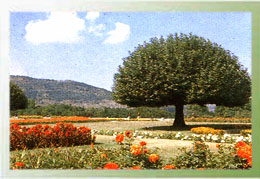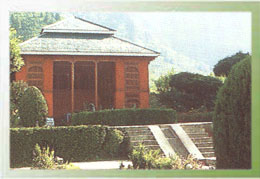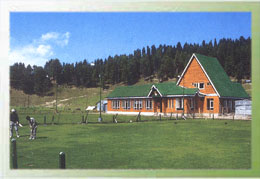|
The lush greenery of the valley with its terraced rice fields, fruit orchards and swirling waterways spill into the city of Srinagar via the Dal Lake and great avenues of popular and chinar trees. This fresh natural atmosphere combined with the commercial clamor of the old city's twisting medieval streets gives Srinagar a distinctive and vitalizing flavor. Most visitors begin their tour of Jammu and Kashmir in Srinagar, with a stay on a legendary houseboat. From houseboats the world of the water people can be observed firsthand. A visit to early morning vegetable market by Shikara is well – worth the extra effort.
General information
Area:
103.3 sq km
Altitude:
1,730 meters (approx).
Best Season:
Throughout the year, though winter months are quite cold.
Clothing
Summer- Cottons/Tropical; Winter- Heavy woolens.
Language:
Kashmiri, Urdu, Hindi, English.
Temperature:
Summer- Max.29.5, Min.10.6; Winter- Max.7.3, Min.-1.9.
STD Code: 0194
How to get there
Air
Srinagar Airport (14 km. from the Srinagar city) is connected to Delhi, Amritsar, Jammu, Leh, Chandigarh, Ahmedabad, Bombay.
Rail
Nearest railhead Jammu Tawi (293 km from the Srinagar city) is connected to all parts of the country with mail and express trains.
Road
Srinagar, on National Highway, is connected with all the major places in India and in the State, viz. Jammu 293 km, Leh 434 km, Kargil 204 km, Gulmarg 52 km., Pahalgam 96 km., Delhi 876 km., Chandigarh 630 km. etc.
In and
Around
Dal
Lake
The Dal is famous not only for its beauty, but for its vibrance, because it sustains within its periphery, a life that is unique anywhere in the world. The houseboat and Shikara communities have lived for centuries on the Dal, and so complete is their infrastructure on the lake, that they never have to step on land! Doctors, tailors, bakers- one can see them all in tiny wooden shops on the lake, near picturesque vegetable gardens and acres of lotus gardens.
Nagin Lake
Nagin Lake, which is usually thought of as a separate lake, is also divided from Dal Lake only by a causeway. The causeways are mostly suitable for walkers and bicycles only so they make a very pleasant way of seeing the lake without having to worry about traffic or Shikaras. The main causeway across the lake carries the water pipeline for Srinagar's mains water supply.
Mughal Gardens
Kashmir
was a favorite of the Mughal emperors who visited it as often
as they could. Cool and refreshing after the plains of North
India where the business of governance kept them, they planted
gardens with stepped terraces and flowing watercourses. When
they rested in their gardens, they dreamt they were in
paradise.
The next garden along the road that encircles the Dal is the
Nishat, built by empress Nur Jahan's brother Asaf Khan. The
largest of the gardens, Nishat has several terraces, a central
watercourse and a majestic site between the Dal and the
Zabarwan hills.
The third Mughal garden - the Shalimar - was planted by
Jehangir, the Mughal emperor, whose love for Kashmir was
legendary. Shaded by magnificent Chinar trees, the Shalimar is
a series of stone pavilions and flowing water with paint box
bright flowerbeds.
Shalimar Bagh
The
Shalimar were built by Emperor Jehangir for his wife Nur Jahan,
'light of the world' in 1616. Although it is known today as
the 'garden of love' it was originally named the Farah Bakhsh
or 'delightful garden'.
The garden is built in four terraces with traditional
water channel running down the middle. The gardens measure 540
by 183 metres. During the Mughal period the top terraces used
be reserved for the emperor and the ladies of the court and
was the most magnificent. It included a pavilion made of black
stone in the middle of the tank. Black Marble fluted pillars
supported the pavilion, which was used as a banquet hall.
Shalimar Bagh has an air of seclusion and repose, and its rows
of fountains and shaded trees seem to recede towards the
snowcapped mountains. A Son Et Lumeiere or sound and light
show is put on here every evening during the May to October
tourist season.
Parimahal
The old Sufi college of Pari Mahal, the 'palace of
the fairies', is only a short distance above the Chasma Shahi
gardens. One can easily walk from the gardens up to the Pari
Mahal then follow a footpath directly down the hill to the
road that runs by the Oberoi Palace Hotel. The Pari Mahal
consists of a series of arched terraces. Recently it has been
turned into a very pleasant and well-kept garden with fine
views over Dal Lake. It's attractively sited on a spur of the
Zabarwan Mountains. The gardens are beautifully kept even
today and a Son Et Lumiere show is put on here every evening
during the May to October tourist season.
Nishat Bagh
 The
Nishat Bagh is another lovely garden with its 12 terraces
representing the 12 signs of the zodiac, which descend
gradually and seem to almost merge into the lake. It is
situated on the banks of world famous Dal Lake in the backdrop
of Zabarwan hills. With its flowerbeds, trees, fountains, the
Nishat presents a dramatic sight. The gardens were designed in
1633 by Asaf Khan, brother of Nur Jahan, and follow the same
pattern as the Shalimar gardens with a polished stone channel
running down the centre and a series of terraces. The
Nishat Bagh is another lovely garden with its 12 terraces
representing the 12 signs of the zodiac, which descend
gradually and seem to almost merge into the lake. It is
situated on the banks of world famous Dal Lake in the backdrop
of Zabarwan hills. With its flowerbeds, trees, fountains, the
Nishat presents a dramatic sight. The gardens were designed in
1633 by Asaf Khan, brother of Nur Jahan, and follow the same
pattern as the Shalimar gardens with a polished stone channel
running down the centre and a series of terraces.
It's the largest of the Mughal gardens measuring 548 metres by
338 metres, and often the most crowed. The walks beside the
channel are bordered with lines of cypresses and Chinars. Also
found within its vicinity are some remains of Mughal period
buildings including a double storey pavilion enclosed on two
sides latticed windows.
Directly behind the garden is the Gopi Tirth, a small spring
gushing forth crystal clear water, which feeds the garden
water.
Chasme Shai
 Cheshma
Shahi is the first Mughal garden one will pass after Nehru
Park. Built at a height above the city, its views are as
stupendous as its layout. The smallest of Srinagar's Mughal
gardens, Cheshma Shahi has only three terraces in addition to
a natural spring of water enclosed in a stone pavilion. Cheshma
Shahi is the first Mughal garden one will pass after Nehru
Park. Built at a height above the city, its views are as
stupendous as its layout. The smallest of Srinagar's Mughal
gardens, Cheshma Shahi has only three terraces in addition to
a natural spring of water enclosed in a stone pavilion.
Smallest of the Srinagar Mughal gardens, measuring just 108
metres by 38 metres, the Chasma Shahi, or 'Royal Spring', are
well up the hillside, above the Nehru Memorial Park. The fresh
water spring in these pleasant, quieter gardens is reputed to
have medicinal properties.
The gardens were laid out in 1632 by Ali Mardan Khan and
include three terraces, an aqueduct, waterfalls and fountains.
The water from the spring supplies the fountains and then goes
through the floor of the pavilion and falls to the lower
terrace in a fine cascade of five metres, over a polished
black stone chute.
Some extensions have recently been made to the gardens. Like
all the gardens the Chasma Shahi is open from sunrise to
sunset but unlike the other gardens this is the only one,
which charges admission. There is a small shrine, the Chasma
Sahibi, near the gardens, which also has a fresh water spring
Hazratbal
Mosque
Hazratbal
Mosque is located in a village of the same name on the banks
of the Dal. Its pristine white marble elegance is reflected in
the waters of the lake.
Hazratbal's
special significance is derived from the fact that it houses a
hair of the prophet Muhammad. This is displayed to the public
on religious occasions, usually accompanied by fairs. Apart
from these occasions, Friday prayers are offered at Hazratbal
and attended by throngs of people. Hazratbal is remarkable for
being the only domed mosque in Srinagar; the others having
distinct pagoda like roofs. The shrine – mosque complex is
situated on the western shore of the Dal Lake opposite Nishat
Bagh and commands a grand view of the lake and the mountain
beyond.
Shankaracharya
Temple
The sacred
temple of Shankaracharya occupies the top of the hills known
as Takht-I-Sulaiman in the south-east of Srinagar. The site
dates back to 250BC. The philosopher Shankaracharya stayed at
this place when he visited Kashmir ten centuries ago to revive
Sanatan Dharma.
Before this
date, the temple was known as Gopadri, as an earlier edifice
on the same site was built by king Lalitaditya in the 6th
century AD. In fact, the road below the hill, with residences
of high- ranking State Government officials, is still known as
Gupkar road. Built on a high octagonal plinth and approached
by a flight of steps with side walls that once bore
inscriptions, the main surviving shrine consists of a circular
cell. It overlooks the Valley and can be approached by a
motorable road. A modern ceiling covers the inner sanctum and
an inscription in Persian traces its origin to the reign of
Emperor Shah Jehan. The original ceiling was dome- shaped and
the brick roof, it appears, is not more than a century old.
Khanqah of Shah Hamadan
Situated on the banks of the river Jhelum, between the third
and fourth bridge, it is the first mosque ever built in Srinagar.
The original one was built in 1395.
Shah Hamadan's
full name was Mir Sayed Ali Hamadni, the surname being derived
from the city of Hamadan in Persia. Shah-i-Hamdan, who came
from Persia in the 13th century, was responsible for the
spread of Islam in Kashmir.
Hari
Parbat Fort & Temple of Sharika Devi
The Mughal
emperor's fort crowns the top of Hari Parbat hill. There is
little left of its former glory, but the ramparts
are still impressive and the old apartments within the fort,
even though in a state of ruin, still convey at least a little
of the grandeur of the Mughals’ summer retreat in
‘paradise’. The fort was later developed in 18th
century by an Afghan governor, Ata Mohammad Khan. The hill is
considered sacred to the Hindus due to the presence of temple
of Sharika, which is believed to be a form of
goddess Durga or Shakti. The wall around the hill was built by
Akbar in 1592-98 AD. The hill is surrounded by almond
orchards, which make a lovely sight during April when the
trees blossom, heralding the advent of spring in Kashmir
Excursions
Pahalgam
About 95 km from Srinagar, at an altitude of 2130m. situated at the junction of the East and west Lidder rivers, Pahalgam was a popular base for trekking before the present troubles.
Pahalgam is
probaly the most popular hill resort in the Kashmir valley.
Since it is rather lower than Gulmarg the nighttime
temperatures do not drop so low and it has the further
advantage of the beautiful Lidder River running right through
the town.
Pahalgam is situated at the junction of the Aru and Sheshnag
Rivers and surrounded by soaring, fir-covered mountains with
bare, snow-capped peaks rising behind them. The Aru flows down
from the Kolahoi glacier beyond Lidderwat while the Sheshnag
from glaciers along the great Himalayan.
At the confluence of the streams flowing from the river Lidder
and Sheshnag Lake, Pahalgam was once a humble shepherd's
village with breathtaking views. Now it Kashmir's premier
resort, cool even during the height of summer. A number of
hotels and lodges cater to all preferences and budgets, from
luxurious to unpretentious trekkers' lodges, including JKTDC's
delightfully romantic, fully furnished huts, partially
concealed by giant pine trees.
Gulmarg
 52 km south-west of Srinagar at 2730m. the name means Meadow of flowers and in spring it's just that. This was also a popular trekking base. 52 km south-west of Srinagar at 2730m. the name means Meadow of flowers and in spring it's just that. This was also a popular trekking base.
Interesting places in the south-west of the Kashmir valley include Yusmarg, reputed to have the best spring flowers in Kashmir. Chari Sharif, is on the road to Yusmarg. Its famous shrine (ziarat) of Kashmiri's patron saint was destroyed in May 1995.
Dachigam National Park
Originally a royal game preserve, rich both in flora and fauna, is 21 km from Srinagar ahead Harwan. Animals such as Himalayan black bear, brown bear, musk deer, the hangul or Kashmir stag and Panther haunt its wild expanses.
Wular lake
The largest fresh water lake in India. Jhelum passes right through its heart. Zaina Lank a small but a picturesque island adds to the fascination of the lake.
Sonamarg
At 2740m, is the last major town before Ladakh. Its name means Meadow of gold, which could derive from the spring flowers or from the strategic trading position is once enjoyed.
Sonamarg is the
base of a major trek that passes along several mountain lakes
–Vishansar, Kishansar, Gadsar, Satsar and Gangabal. Sonamarg
is also the take off station for the drive to Ladakh across
the Zojila, a major pass in the Great Himalayan Range, through
which the Srinagar-Leh Road passes.
The Meadow
Of Gold
At a height of 2,740m, Sonamarg is the last major point in the
Kashmir valley before the Zoji La pass into Ladakh . At the
pass the green, lush Kashmiri landscape abruptly switches to
the barren, dry landscape of Ladakh. Sonamarg is thus not only
a good base for treks but also a jumping off point for trips
into Ladakh.
The name means 'Meadow of Gold' and although this could be due
to the profusion of flowers that carpet the meadow in the
spring it is also possible that the name derives from
Sonamarg's strategic trading position in the days when this
was a major route into central Asia. The Sindh River meanders
along here and abounds with Trout and Mahseer.
Walks From Sonamarg
Oneof the most popular short walks from Sonamarg and a major
attraction during the summer months is the 4-km route to
Thajiwas, a small valley at the foot of the Sonamarg glacier.
A path leads up to the Shakhdar hill, overlooking the glacier
from the northeast. It is dangerous to climb the steep slope
leading up to the glacier. Ponies can be hired for the trip up
to Thajiwas glacier. Often in early summer one will meet
groups of Gujar passing through Sonamarg on their way to the
alpine meadows for the summer |



